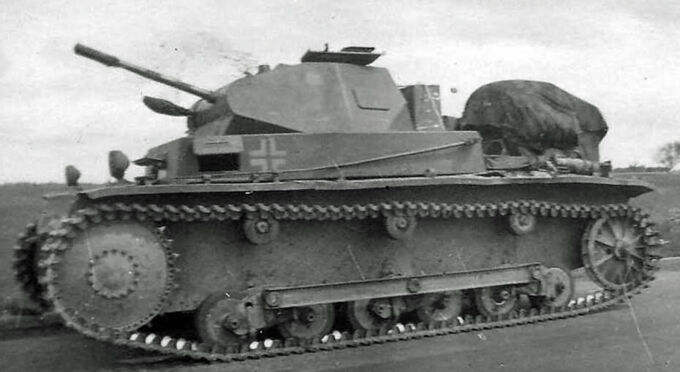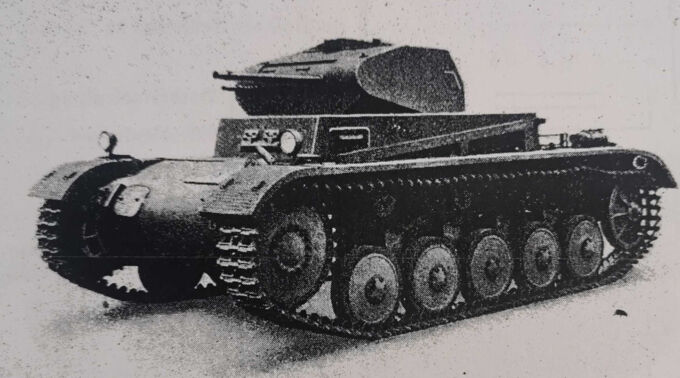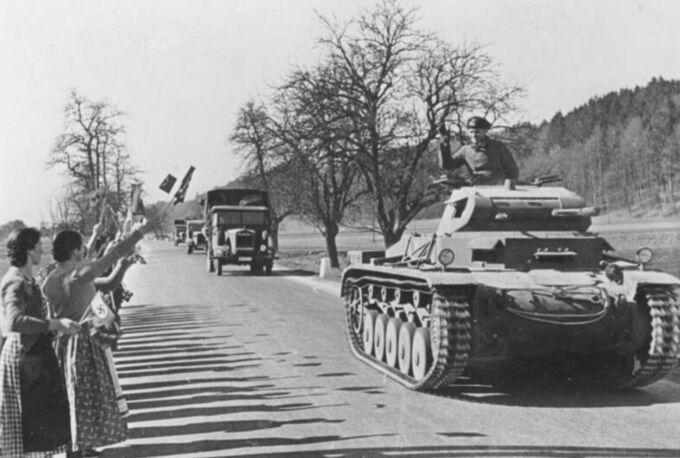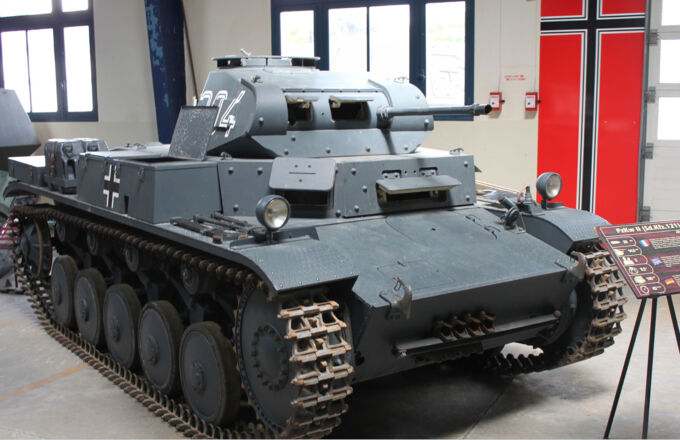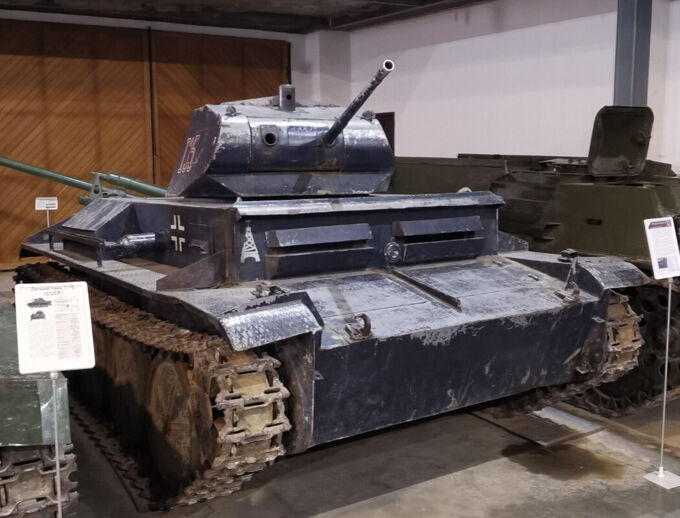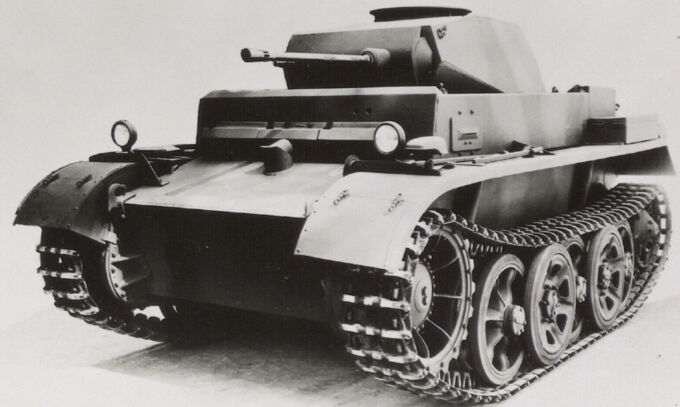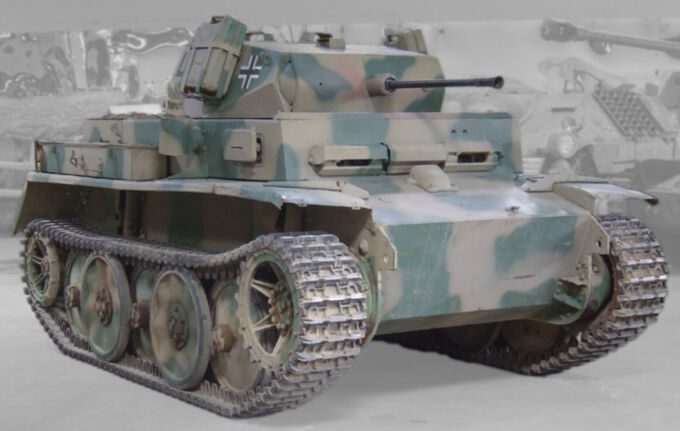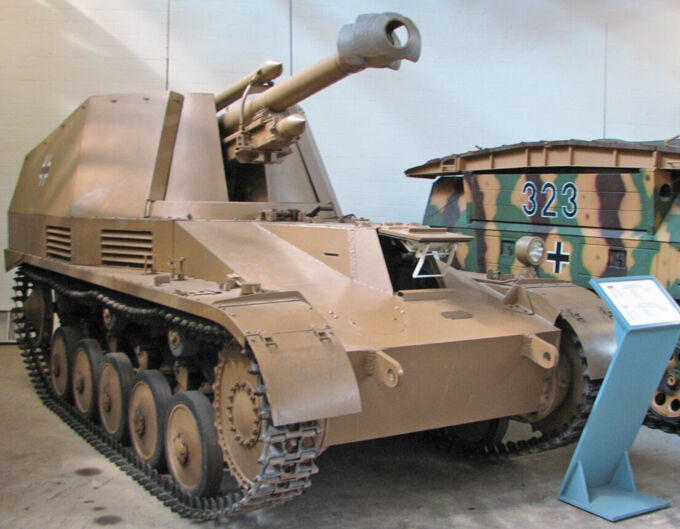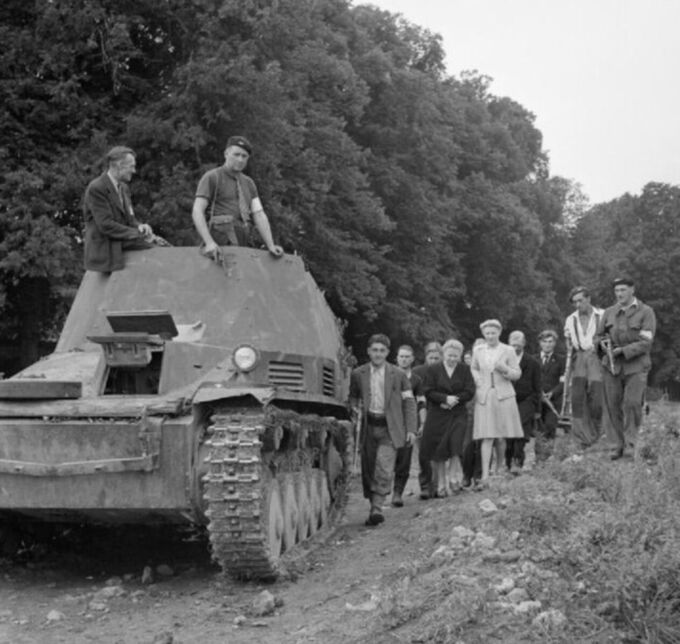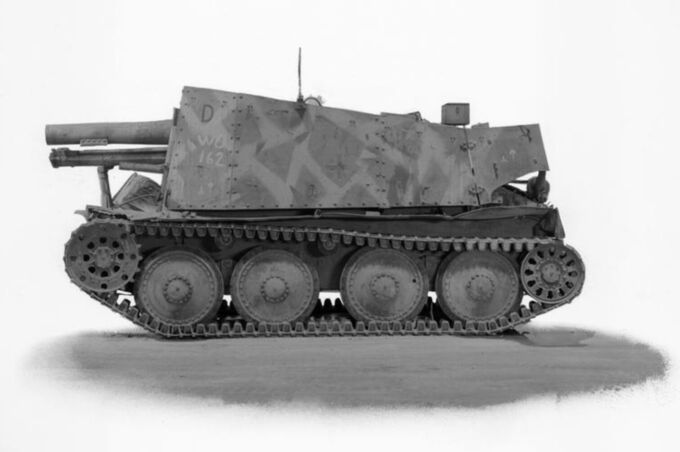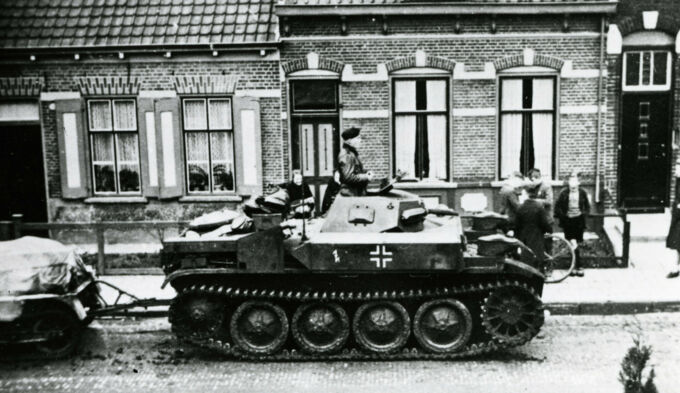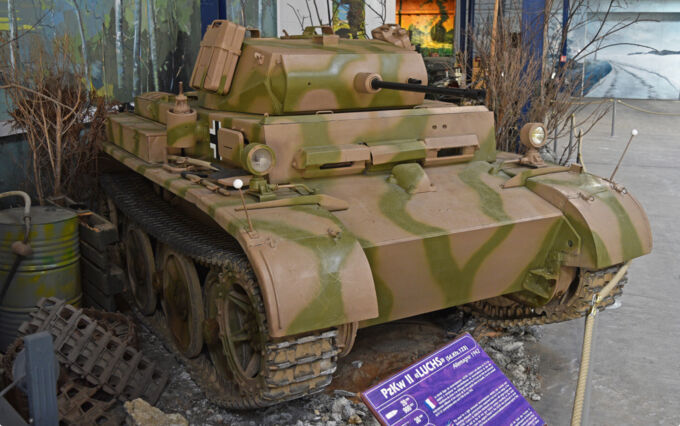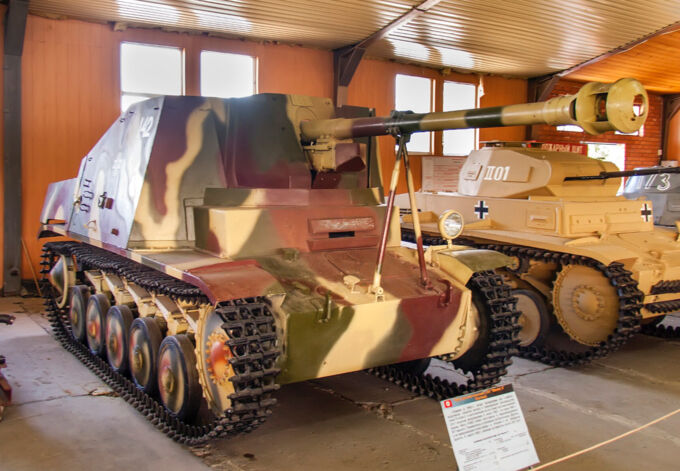The Panzerkampfwagen II, also known as the PzKpfw II, Panzer II, or Sd.Kfz 121 was a light German tank used in World War II and the pre-war period. Developed in the 1930s by MAN and Daimler-Benz, it was intended as a temporary solution and formed the backbone of the Wehrmacht’s armored divisions at the beginning of the war. A total of 3,404 Panzer II’s of various types were built. They were used not only by Germany but also by Romania, Slovakia, and Norway.
Development
The General Defense Office (Allgemeine Heeresamt = AHA), which was responsible for equipping the German armed forces and pursued long-term equipment goals by placing production orders with industry, realized in the early 1930s that the development and production of the two main types with which future tank units were to be equipped: the platoon leader vehicle, later Panzer III, and the escort vehicle, later Panzer IV, would take longer than expected. Therefore, on January 21, 1934, the AHA commissioned the Army Ordnance Office (Herres Waffenamt = HWA) to develop a “reinforced 6-ton small tractor” code-named “Agricultural Tractor La. S.100” with a more powerful engine, now producing 100 hp, and more powerful armament, namely a 2 cm KwK 30 automatic cannon; later a 2 cm KwK 38 automatic cannon and an MG 34.
The responsible department of the HWA, WaPrüf 6, decided to continue on the path it had chosen and build on Krupp’s experience, so Krupp was again commissioned to develop the chassis. On February 24, 1934, representatives of the AHA, the HWA, and a Mr. Hagelloch from Krupp met, at which Krupp promised to present drawings of a new concept by the end of March. Daimler-Benz, which had also designed the Panzer I, was again entrusted with developing the body. Krupp promised to deliver a complete prototype with body and turret by the end of 1934 if the HWA placed an order promptly.
The Armaments Office decided to involve several companies in the project. Henschel and MAN were also informed about the project. Several meetings were held in the summer of 1934, during which HWA employees informed the companies' development departments about the project’s goals and requirements. The Army Armaments Office was committed to delivering quickly and developing the best possible design within this short timeframe. Therefore, it was hoped that the development contracts awarded to the various companies would produce different solutions that combined and assembled the best design components.
Variants
Pre-Series
Pz.II a1, Pz.II a2, Pz.II a3
The first vehicles in the small series were the “a” versions, of which three small series of 25 were produced each. Their origins from the Panzerkampfwagen I and their proximity to conventional chassis solutions based on the Carden-Loyd chassis are evident in these vehicles. They featured small pairs of road rollers, each with a spring suspension and reinforced on the outside by a cross member. In the a1 version, the first ten vehicles used a rubberized deflection pulley and smaller track and support rollers.
The track was later replaced with a 2 cm wider track, which also required replacement of the track and support rollers. The vehicles weighed 7.2 tons, had a six-cylinder Maybach gasoline engine with 130 hp, and a countershaft transmission without reduction gear. The 25 a/2 versions produced in the same year (1935) featured improvements to the engine compartment and cooling system. The final variant of this small series was 25 units of the a/3 version, which featured modifications to the cooling system, tracks, and suspension. The vehicles were manufactured by MAN and Daimler-Benz from May 1936 to February 1937.
Pz.II b
Since the engine power was deemed insufficient, a 140-hp Maybach engine was installed in version b. The 100 vehicles of this series featured a new reduction gear and the definitive tracks of the Panzer II series. The weight increased to 7.9 tons.
Pz.II c
Version c, released in 1937, featured the definitive Panzer II chassis, with five road wheels suspended on quarter springs. Development ended with the 75 vehicles of this version, and series production began.
Production Series
Pz.II A, Pz.II B
With the A version, the SSG 46 manual transmission was adopted as standard equipment. The floor valves were relocated and enlarged, the radiator received a drain, and the firewall received a maintenance hatch. Regarding the fuel supply and engine lubrication, the diameter of the fuel line was changed to 8 mm, and the fuel pump, oil filter, and oil cooler were relocated. In addition, the steering gear lubrication system was simplified. The electrical system was suppressed due to problems with the reception of ultrashortwave signals for the radio system. 210 vehicles of the A version were built. The B variant comprised 384 vehicles, which differed only slightly from the A variant. It only had thicker armored glass for the viewing slits. Ultimately, the viewing slits on the B variant were enlarged.
Pz.II C
The C variant comprised 364 vehicles. Due to the delay in series production of the Panzerkampfwagen III, this was used for the production of additional Panzerkampfwagen II vehicles. At the beginning of the 7./La.S.100 series, the viewing hatches with protective glass were mounted as standard behind the hatch on the inside of the tank wall. With the introduction of the Turm-Ziel-Fernrohr 4 (T.Z.F. 4), the aiming optics were increased to a range of 1,200 m.
Pz.II D
43 vehicles of the D variant were built. With a new torsion bar suspension and four road wheels, the Ausf. D was developed as a tank for use in light divisions. Only the turret was the same as the Ausf. C model, with a new hull and superstructure design and the use of a Maybach HL62TRM engine and seven-speed gearbox. The design was shorter at 4.65 m as opposed to the C variant at 4.81 m, but wider at 2.3 m as opposed to the previous 2.2 m and taller at 2.06 m as opposed to the previous 1.99 m as compared to the Ausf. C. The speed was also increased to 55 km/h. They were taken out of service in March 1940 for conversion to the flamethrower-armed Panzer II (Flamingo).
Pz.II F
Variant F comprised 509 vehicles and, based on combat experience, was deemed necessary to reinforce the armor. Again, based on the chassis of versions A-C, the hull’s frontal armor was increased to 35 mm, the turret’s frontal armor to 30 mm, and the side armor to 20 mm. Other changes included a new conical idler wheel and a blind sight mounted next to the driver’s hatch, likely intended to reduce enemy fire on the driver’s visor.
Pz.II G / VK.9.01
In June 1938, MAN and Daimler-Benz were commissioned to develop a high-speed reconnaissance tank based on the Panzer II. The result was the VK 9.01, equipped with a box-type chassis and a 145 hp engine and weighing 9.2 t, which reached a speed of 50 km/h. The targeted top speed of 60 km/h was achieved with a later 200 hp engine. It is unlikely that the pilot series of 45 vehicles, delivered in October 1940, was ever delivered to the combat troops. The armament consisted of an MG 141 (or an EW 141 integrated weapon) and a coaxially mounted MG 34.
Pz.II H/VK.9.03
The VK 9.03 was a successor of sorts to the Pz.II, of which only a prototype was built. In 1941, the General Army Office demanded a tank in the 10-ton class that would have increased speed and improved armor. A development chassis was delivered by MAN in September 1941. The 10.5-ton vehicle, equipped with a 200-hp six-cylinder Maybach gasoline engine, reached a speed of 65 km/h. The vehicle was 30 mm thick at the front and 20 mm thick at the sides and rear. Otherwise, the H version did not differ externally from the G version. Its armament consisted of the 2 cm KwK 38 L/55 cannon and an MG 34. Since the vehicle was already obsolete by the time production was expected to begin in mid-1942, the project was discontinued.
Pz.Sfl.IC
The Pz.Sfl.I.c is based on the chassis of the Pz.II H and is also referred to as the Pz. II H. It was a prototype designed to improve the firepower of the Pz. II, which is why it was armed with a 50 mm Pak 38 gun, which had an open turret and was declared a self-propelled gun.
Pz.II J / VK.16.01
At the end of 1939, another development contract was awarded with the goal of stronger armor. The 80 mm thick frontal armor and 50 mm thick side armor increased the total weight to almost 18 tons. With a 150 hp engine, a top speed of 30 km/h was achieved. Like the G version, the tank had a box-type chassis and was armed with the 2 cm KwK 38 L/55 cannon and an MG 34. A total of 30 vehicles of the J variant were built.
Pz.II L “Luchs”
Since the terrain, especially on the Eastern Front, made the use of wheeled vehicles for reconnaissance difficult, a decision was made, following a request first made by the Army Ordnance Office in September 1939, to create a fully tracked reconnaissance tank. Based on the experience gained with the G and J versions, the VK 13.01 was developed, of which a prototype was built. After a few modifications, the vehicle, now called the VK 13.03, went into series production in September 1942.
The frontal armor was 30 mm thick, while the side armor was 20 mm thick. The crew consisted of four men. The twelve-ton vehicle, powered by a 180-hp gasoline engine, reached a top speed of 60 km/h, which was advantageous for a reconnaissance tank. Due to its exclusive use as a reconnaissance vehicle, its official designation was “Panzer-Spähwagen II Luchs” (armored reconnaissance vehicle Lynx). The large-scale order for 800 units was placed, but production was discontinued in January 1944. By then, 100 vehicles had been manufactured and handed over to the reconnaissance units of the Panzer divisions.
Pz.II M
The Pz.II Ausf. M was based on the chassis of the Pz.II Ausf. H and was an attempt to improve the Panzer II. The development aimed to increase the vehicle’s mobility, armor, and armor. To this end, considerations were given to installing a 2.8 cm Pak or a 5 cm Kwk 39 instead of the previous 2 cm Kwk gun on the Ausf. M. In August 1942, MAN produced four prototypes of the Ausf. M with the 2 cm Kwk. However, these vehicles never entered active service and were not mass-produced, remaining in the prototype stage.
VK.16.02 Leopard
Despite its weak combat power, development of the series was still not complete, as the Army Ordnance Office awarded MIAG and Daimler-Benz the contract to create a heavy, fully tracked reconnaissance vehicle. Officially designated the VK 16.02, it was subsequently developed and nicknamed the Leopard. Its turret armor was 50 to 80 mm thick, and its hull armor was 20 to 60 mm thick. Weighing approximately 26 tons, a 550 hp gasoline engine was designed to give the tank a top speed of 60 km/h. The vehicle never saw production, but the fully constructed turret was used for the Sd.Kfz. 234/2 armored reconnaissance vehicle.
Marder II
Since the weak points of the series quickly became apparent, some of the chassis were used for various self-propelled guns, which for the most part proved more effective in their respective roles than the actual Panzerkampfwagen. In late 1941, in light of the identified deficiencies of motorized anti-tank defense, the order was given to convert the Panzer II chassis into a tank destroyer that would be equipped with the Red Army’s massively captured 7.62 cm anti-tank gun.
By May 1942, 150 of the Marder II vehicles had been delivered; 51 more Sd.Kfz. 132s were to follow shortly thereafter, as soon as repaired chassis that had previously been salvaged became available. The Marder II, which was equipped with the German PaK 40, received the designation Sd.Kfz. 131 from June 1942. 576 of this type were built from scratch and a further 75 were converted from Panzer IIs. Trials with the 5 cm PaK 38, with which two converted vehicles arrived at the front in January 1942, were discontinued due to its insufficient penetration compared to the T-34. Although the tank destroyer was only lightly armored due to its 15 mm thick protective shields and had an open-topped fighting compartment, it provided significant assistance in anti-tank defense in the eastern theater of war.
Wespe
The most famous self-propelled gun on the Panzer II chassis was the Wespe (Sdkfz. 124) self-propelled howitzer, which first saw action during Operation Citadel. The vehicle was armed with the 10.5 cm light field howitzer, for which the Wespe had 32 rounds of ammunition. The open-topped fighting compartment was armored all around with 10 mm shields. It weighed 11.5 tons and carried a crew of five.
In addition to the 683 examples, there were 158 ammunition transporters, which were similar in design to the Wespe except that the gun had been removed. Equipped with 90 rounds of ammunition, they could follow the self-propelled howitzers into battle. It was also possible to convert the ammunition transporter into a self-propelled howitzer by installing the gun from a damaged Wespe. This conversion could even be carried out in the field (like the Panzerwerfer 42).
15-cm-slG 33 “Bison II”
The 15cm slG 33 B Sfl (Bison II) was a German self-propelled howitzer from World War II. In 1940, the Wehrmacht planned to equip its infantry divisions with motorized infantry guns. During the Western Campaign, a 15 cm SLG 33 howitzer was built as a temporary solution to replace a Pz. I tank, nicknamed the “Bison.” However, problems arose with the engine and armament of the chassis and gun. The Wehrmacht commissioned Alkett to develop a new version based on the Pz.II. Alkett then developed a vehicle using components from the Panzerkampfwagen II. It was 60 cm longer and 32 cm wider than a Panzerkampfwagen II Ausf. F and thus naturally heavier.
The hull was 30 mm thick, and the gun’s protective shield was 14.5 mm armored. The vehicle was open at the top. The total weight was 12 tons. The top speed was 45 km/h, and the road range was only 100 km. The chassis was completely taken from the Panzer II, but an additional road wheel was added to accommodate the longer hull. During the African campaign, several problems arose with the engine. The Bison II was not sufficiently reinforced for its weight and had no air filter, which made it prone to engine failure and damage, especially in Africa. Due to the numerous technical problems, the Bison II project was considered a failure, and development began on the StuIG 33 B motorized infantry gun and the 15 cm Schweres-Infantrie-Schütz 33 auf Panzerkampfwagen 38(t) Ausf. H “Grille”.
Flamm Panzer II “Flamingo”
In January 1939, MAN and Wegmann were awarded a development contract for a light flamethrower tank. By April 1942, a total of 95 of the officially designated PzKpfw II Fl (Fl = Flammenwerfer / Flamethrower) (Sd.Kfz. 122) were in the special tank formations, some of which were converted from the D and E versions. The Flammpanzer II was armed with an MG 34 in a much smaller turret and two lightly armored flamethrowers, each located at the front end of the track cover plates. The flamethrowers, housed in a mini-turret, could be rotated 180° and adjusted in elevation by up to 20°.
They were fed by an external, armored fuel tank located behind each tank, each with a capacity of 160 liters. This allowed around 80 bursts of fire lasting two to three seconds at a range of 35 meters. The petroleum, commonly used as a flame agent, was expelled through compressed nitrogen and ignited with an acetylene flame. The flamethrowers were controlled by the commander using two cranks on the turret’s dashboard, which individually aligned the spray heads via chains. To create a smoke bank, a group of three smoke canisters was located in the rear of the track cover. The flamethrower system was simple and reliable; the Panzerkampfwagen II was considered a proven flame-armored tank. Because of its light armor, the “Flamingo” was vulnerable to fire.
Surviving examples
There are only a few examples of the Pz.II that have survived. Here are a few examples.
Deutsches Panzer Museum
Museum De Blindés
Tank Museum Bovington
Kubinka Tank Museum
Sources
- [Wiki DE] Panzerkampfwagen II
- [Wiki DE] Mader II
- [Wiki DE] Panzerhaubitze Wespe
- [Wiki DE] 15-cm-slG 33 (Sf) auf Panzer II
- [Wikiwand DE] Panzerhaubitze Wespe (Feldhaubitze 18/2 auf Panzerkampfwagen II)
- [Wiki DE] 2-cm-KwK 30 / 2-cm-KwK 38
- [Wiki EN] Panzer II
- [Wiki EN] Mader II
- [Wiki EN] Wespe
- [Wiki EN] VK 16.02 Leopard
- [Wiki EN] Panzer I Ausf. C
- [Wiki EN] German army armored figthing vehicel production during world war II
- [Tank Encyclopedia] Panzerkampfwagen II Ausf.G (VK 9.01)
- [Tank Encyclopedia] Panzerkampfwagen II Ausf.H & Ausf.M
- [Panther Panzer DE] Panzer II a1, a2, a3
- [Lexikon der Wehrmacht DE] Panzerkampfwagen II





